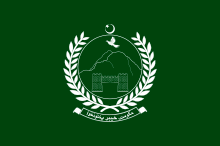Kalu Khan
| Kalu Khan کالوخان | ||
|---|---|---|
| Town | ||
| ||
 Kalu Khan | ||
| Coordinates: 34°13′0″N 72°18′0″E / 34.21667°N 72.30000°ECoordinates: 34°13′0″N 72°18′0″E / 34.21667°N 72.30000°E | ||
| Country |
| |
| Province | Khyber-Pakhtunkhwa | |
| District | Razzar,Swabi District | |
| Elevation | 317 m (1,040 ft) | |
Kalu Khan is a village located between Shewa-Adda and Adina village on the main Mardan-Swabi road. It was recently upgraded to the status of "Tehsil Headquarters" of District Swabi. The tehsil head-quarter although located in Kalukhan is named Tehsil "Razar" and not Tehsil Kalukhan. The name Razar originates from the genealogy of the inhabitants of this tehsil which when traced back is linked to a man named Razar who was one of the four sons of Mandanr. The people of this tehsil are the sons of Mandanr and belong to the Mandanr branch of the Yousafzai (Isapzy in pashto) tribe of Afghans through his son Razar. Beside the Yousafzais or Isapzais there are also Akhundzadas, Syeds and Mians (sons of the Sufis and Islamic preachers) who came along with the former somewhere between 1490 and 1510 AD from the Kabul region of Afghanistan. Some other families living in the Tehsil are Awans and Kamangar who may or may not be Afghans but were allotted lands after their good performances during the old tribal wars. Some others also reside here who did not own any land but provided different services to the land-owners.
The name of the village is after a famous 16th century tribal army general named Malak Kalukhan. The Malak here is an ancient pakhtun title only and is not to be confused with the Malik families of the Punjab. He is believed to fight the Mughal Emperor of his Era who was Akbar, he fought him for freedom of his states and for his tribe and nation, he got several times jailed by Akbar at his capital in Delhi but instead of punishing and torturing him he begun to like him, because of which he escaped from there and fought many battles with Mughals.
Like every other village in the Isapzai country - stretching from the plains of present day Swabi and east-Mardan in the South to the valleys of Buner and Swat in the north - the land of Kalukhan village is divided among five main families of the Mandanr branch. These families or Khels (in pashto) are the Munankhel, Mamakhel, Bazidkhel, Fatmakhel and Lodarkhel. Like other villages, Kalu Khan land was divided into four equal parts or wands (in pashto) with each of the four khels or family carrying equal possession in all the wands. This divisions of land was carried out by Sheikh Malli Baba of the Yousafzai tribe sometime between 1530-1540 AD on the instructions of Malak Ahmed Khan, the then chief of the tribe, who himself was a Mandanr. With the passage of time each family's population has risen manifolds and the inherited land in some cases during the current times is left to a negligible share.
Kalu Khan is well known for its production of Kalu khani talay (dish) in old times and Kalukhanay paroonay (or shawl for women) which is still in vogue. The land is very fertile and produces good quality wheat, sugarcane, tobacco and corn.
It is located at 34°13'0N 72°18'0E with an altitude of 317 meters (1043 feet).[1]
Kalu khan has a hospital which is now upgraded to the Tehsil Headquarters Hospital and a police station which is the oldest in the area. There is a government high school and college for girls with over 2,000 students, and a high school for boys.
The village is surrounded by the villages of Turlanday and Yar-Hussain on the south-east and south-west respectively and by Adina village on the west. To the north is the karamar mountain and to north east is the village Shawwa or Shewa.
References
